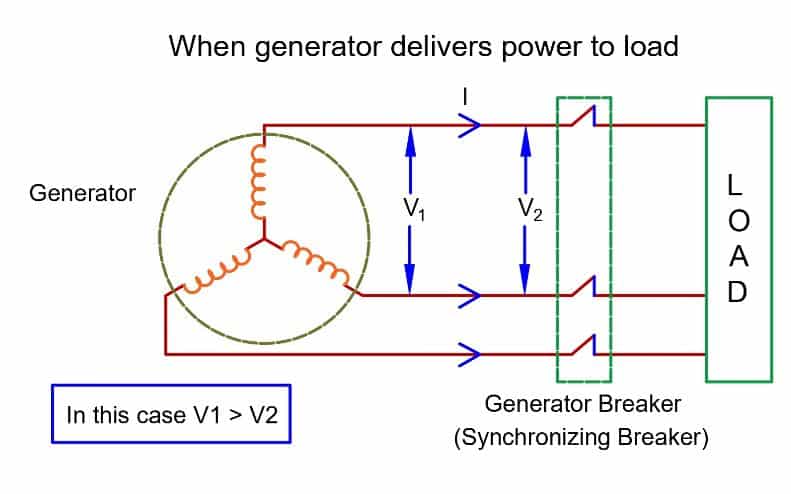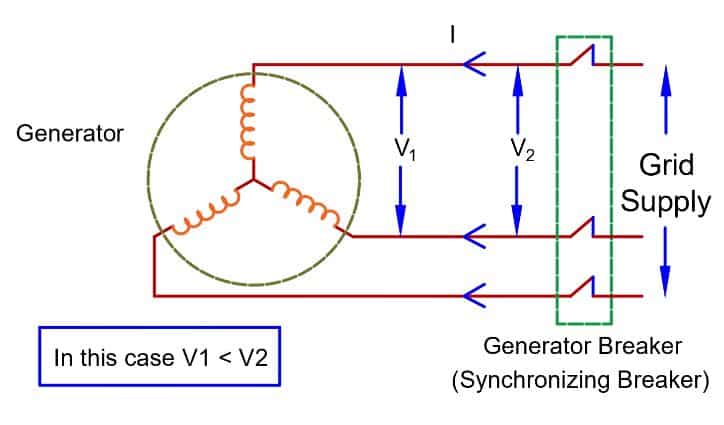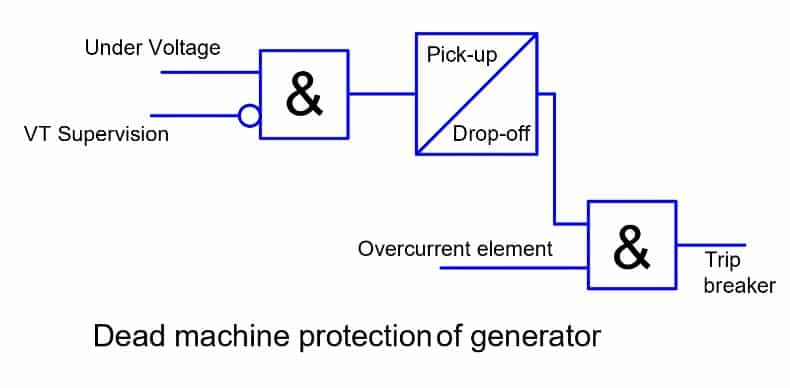Dead machine protection protects the generator from energization when it is at a standstill condition. The ANSI code for dead machine protection is 94G. The energization of the generator circuit breaker when the generator is not working can cause severe damage to the generator.
Why Dead Machine Protection?
Let us discuss what happens when the generator is at standstill or it is running on turning gear.
The generator generates electricity when the actual speed of the rotor is more than the synchronous speed of the generator. In this condition the slip is negative. If you recall slip formula, slip is the difference between synchronous speed and actual speed.
s = (Ns-N)/Ns
When N( generator rotor speed) is more than the synchronous speed of the generator, the slip is negative, and thus generator functions in the generating mode.
The reverse of the above process is possible, and in this case, the generator behaves as a motor. When the generator is at standstill means the rotor or field of the generator is not rotating or rotating at slow speed on turning gear. We can say rotor speed(N) in this case is zero.
Now, if accidentally the generator breaker closes, then the stator of voltage receives the full voltage and it produces the rotating magnetic field in the air gap. The slip, in this case, will be,
s = (Ns-N)/Ns
s = 1 ( Because N =0)
In this condition, the slip is almost equal to unity and the generator will act as a motor. The generator will draw an enormously high inrush current from the supply system and it may cause severe damage.
When the generator is at standstill, the oil pump remains off and does not supply oil to sleeve bearings. If the generator accidentally operates in motoring mode the bearing may damage because of a lack of oil pressure in the sleeve bearings.
From the above-given facts, we can say that the generator must not start in the motoring mode in any case. To ensure the protection against the running of the generator as a motor, dead machine protection of the generator is a must.
Monitoring Parameters for Dead Machine Protection
Let us discuss the parameters we need to detect for providing the dead machine protection.
1. Stator or Armature Voltage
When the generator delivers power to load, the current flows from the generator terminal to the load terminal. In this condition, the voltage drop takes place between the generator terminals and the stator or armature breaker. Let us say the voltage at the generator terminal is V1 and the voltage at the generator breaker is V2.

When the generator functions in generating mode then V1>V2
When the generator operates in motoring mode, the voltage(V1) at the generator terminal is less than the voltage(V2) at the circuit breaker’s terminals. Here, current flow from the circuit breaker to the generator and voltage drop takes place in between the circuit breaker and generator terminal.
Therefore, when the generator functions in motoring mode, it draw power from the grid, and then V1<V2

Thus, one of the important parameters for detection of the dead machine operation is the measurement of voltage across the generator terminals.
2. Stator or Armature Current
The generator draws a large current, more than the full load current of the generator when the armature or stator of the generator receives the full voltage under no or slow rotation of its rotor. This scenario is just like starting an induction motor at full stator voltage.
Thus, the stator or armature current is the parameter that is used to detect the dead machine operation.
Dead Machine Protection Scheme
As discussed above, there are two parameters used for the detection of dead machine operation.
- The voltage across the generator stator terminals
- Current in the armature winding
Logic of Dead Machine Protection
The logic of dead machine protection is given below.

The VT supervision checks the proper working or healthiness of the stator voltage sensing circuit that includes potential transformer and fuses. The monitoring of fuses is a must for monitoring under voltage for dead machine protection. The dead machine protection will not operate on blowing off the PT fuse if an overcurrent is not sensed. However, if the PT fuse fails or the voltage sensing circuit fails, the dead machine protection will not work, even if it senses the overcurrent. Therefore, for reliable protection, voltage sensing monitoring is a must.
The under voltage is generally set at 85% of the generator’s rated voltage. On sensing under voltage the pickup timer starts and it outputs a signal after a delay of 5 seconds. The generator stator voltage also drops at the time of fault in the system. Thus, this initial delay prevents the initialization of dead machine protection during a system fault.
The drop-off time delay ensures that Dead Machine Protection remains initialized for the set time after an accidental closure of the breaker when the under-voltage element may reset. The drop-off time is generally set between 400 to 500 milliseconds.
One more input for dead machine protection is overcurrent. The overcurrent is set at about 110 % of the full load current of the generator. If the dead machine protection circuit senses both under voltage and overcurrent, it outputs a trip command to the circuit breaker.
Under normal conditions, the under voltage element output is low( In a digital system low means 0 and high means 1). If under voltage output is 1 and the overcurrent element is 0, the dead machine protection will not operate. The dead machine operates only when the under-voltage and overcurrent elements are high(1).
This is all about Dead Machine Protection of Generator.